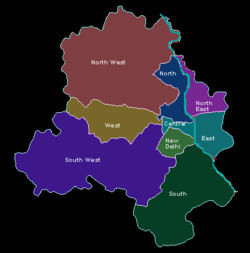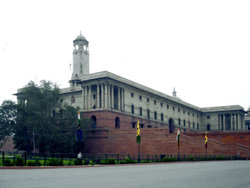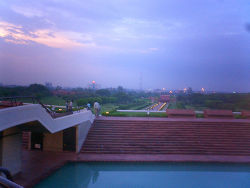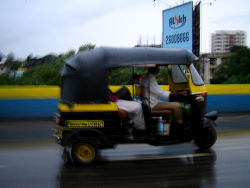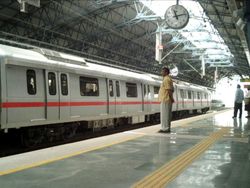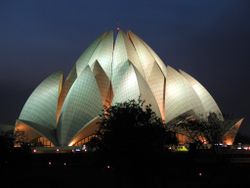Delhi
2007 Schools Wikipedia Selection. Related subjects: Geography of Asia
| Delhi | |
| State - District(s) |
National Capital Territory of Delhi - Delhi |
| Coordinates | |
| Area - Elevation - Districts |
1,483 km² - 293 m - 9 |
| Time zone | IST ( UTC+5:30) |
| Population ( 2006) - Density - Agglomeration ( 2006) |
11,215,130 ( 2nd) - 9,294/km² - 17,753,087 |
| Chief Minister | Sheila Dikshit |
| Lt. Governor | B.L. Joshi |
| Codes - Postal - Telephone - Vehicle |
- 110 xxx - +011 - DL-0? |
| Website: www.mcdonline.gov.in | |
|
Seal of Delhi |
|
Delhi pronunciation ( Hindi: दिल्ली, Urdu: دہلی or دلّی, Punjabi: ਦਿੱਲੀ) is a metropolis in northern India. The name Delhi also refers to the National Capital Territory of Delhi (NCT), which is a special union territory jointly administered by the Central government, the NCT elected government and three municipal corporations. The metropolis of Delhi and the National Capital Territory of Delhi are coextensive and for most practical purposes they are considered to be the same entity. New Delhi, an urban area within the metropolis of Delhi, is the seat of the Government of India.
With a population of 15.3 million people (2005 figure), Delhi is the seventh most populous metropolis in the world . Delhi's metropolitan area, informally known as the National Capital Region (NCR), comprises the NCT, the neighbouring satellite towns of Faridabad and Gurgaon in Haryana, and NOIDA and Ghaziabad in Uttar Pradesh. Altogether, the NCR is the world's sixth most populous agglomeration with a population of 19.7 million.
Delhi was the capital of several empires in ancient India and has over 60,000 recognized monuments erected over several millennia. Delhi derives its historic importance from its position in northern India between the Aravalli Hills to the southwest and the Yamuna River to the east. This enabled it to dominate the old trade routes from northwest India to the Gangetic Plains. As a result, it has long been an important cultural, political, and intellectual centre. Due to a high migration rate, Delhi registers as one of the fastest growing cities in Asia. As a consequence, it faces key issues like environmental degradation, air and water pollution, traffic congestion, and acute power and water shortages.
Etymology
The name "Delhi" is of uncertain etymology. One suggestion is that its eponym is "Dhillu", the name of a Mauryan maharaja. However, some historians believe that the word Dilli, another name for Delhi, orignated from the Persian word dahleez ( Urdu: دہلیز), meaning " frontier" or "threshold". Another theory suggests that the city's original name was Dhillika. The Persianized surname Dahelvi is also related to residents of Delhi. The Hindi/ Prakrit word dhili ("loose") was also used for the locality, gradually morphing into the local name "Dilli".
History
Delhi is believed to be the site of Indraprastha, capital of the Pandavas in the Indian epic Mahabharata, founded perhaps as long ago as 5000 BC. Ancient Hindu texts describe a city in North India called Indraprastha, which means "city of Indra" (God). In later years, according to the ancient texts, parts of the city came to be known as Hastinapur or "the city of elephants". Archaeological evidence suggests that Indraprastha once stood where the Old Fort is today. The earliest architectural relics date back to the Maurya Period (c. 300 BC); since then the site has seen continuous settlement. The famous Iron pillar near the Qutub Minar was commissioned by the emperor Kumara Gupta I of the Gupta dynasty (320-540) and transplanted to Delhi during the 10th century. Eight major cities have been situated in the Delhi area. The first four cities were in the southern part of present-day Delhi.
The Tomara Rajput dynasty founded the city of Lal Kot in 736 A.D. near the Qutub Minar. The epic Prithvirajaraso names the Rajput Anangpal as the founder of Delhi. The Chauhan Rajput kings of Ajmer conquered Lal Kot in 1180 A.D. and renamed it Qila Rai Pithora. The Chauhan king Prithviraj III was defeated in 1192 by the Afghan Muhammad Ghori. From 1206, Delhi became the capital of the Delhi Sultanate under the Slave Dynasty. The first Sultan of Delhi, Qutb-ud-din Aybak was a former slave who rose through the ranks to become a general, a governor and then Sultan of Delhi. Qutb-ud-din started the construction the Qutub Minar to commemorate his victory but died before its completion. In the Qutb complex he also constructed the Quwwat-al-Islam (might of Islam), which is the earliest extant mosque in India. After the end of the Slave dynasty, a succession of Turkic and Central Asian dynasties, the Khilji dynasty, the Tughluq dynasty, the Sayyid dynasty and the Lodhi dynasty held power in the late medieval period and built a sequence of forts and townships that are part of the seven cities of Delhi. In 1526, following the First Battle of Panipat, Zahiruddin Babur, the former ruler of Fergana, defeated the last Lodhi sultan and founded the Mughal dynasty which ruled from Delhi, Agra and Lahore.

In the mid-sixteenth century there was an interruption in the Mughal rule of India as Sher Shah Suri defeated Babur's son Humayun and forced him to flee to Afghanistan and Persia. Sher Shah Suri built the sixth city of Delhi, as well as the old fort known as Purana Qila and the Grand Trunk Road. After Sher Shah Suri’s early death, Humayun recovered the throne with Persian help. The third and greatest Mughal emperor, Akbar, moved the capital to Agra resulting in a decline in the fortunes of Delhi. In the mid-seventeenth century, the Mughal Emperor Shah Jahan (1628-1658) built the seventh city of Delhi that sometimes bears his name ( Shahjahanabad), and is more commonly known as the old city or old Delhi. The old city served as the capital of the later Mughal Empire from 1638 onwards, when Shah Jahan transferred the capital back from Agra. Aurangzeb (1658-1707) crowned himself as emperor in Delhi in 1658. In 1761, Delhi was raided by Ahmed Shah Abdali after the Third battle of Panipat.
Delhi passed to British control in 1857 after the First War of Indian Independence. Shortly after the First War of Independence, Calcutta was declared the capital of British India and Delhi was made a district province of the Punjab. But in 1911, Delhi was again declared as the capital of India. Parts of the old city were pulled down to create New Delhi, a monumental new quarter of the city designed by the British architect Edwin Lutyens to house the government buildings. New Delhi, also known as Lutyens' Delhi, was officially declared as the seat of the Government of India after independence in 1947. During the Partition of India thousands of Hindu and Sikh refugees from West Punjab and Sindh migrated to Delhi.
In 1984, the assassination of then Prime Minister of India, Indira Gandhi, led to a violent backlash against the Sikh community, resulting in more than two thousand seven hundred deaths.
In 1991, the Parliament of India passed the National Capital Territory Act which gave Delhi its own legislative assembly, though with limited powers. On February 16, 2006 the Delhi High Court passed a notice to the Municipal Corporation of Delhi (MCD) to remove all commercial ventures within residential areas in the city.
Geography
Delhi is located at 28.38° N and 77.13° E and lies in northern India. It borders the Indian state of Uttar Pradesh on the south and Haryana on the west. Delhi can be divided into three major geographical regions: the Yamuna flood plain, the ridge and the Gangetic Plains. The low-lying Yamuna flood plains provide fertile alluvial soil suitable for agriculture. However, these plains are prone to recurrent floods. With an average altitude of 293 m above sea level, the ridge forms the most dominating feature in this region. It originates from the Aravalli Hills in the south and encircles the west, northeast and northwest portions of the city. The Great Gangetic Plains are located in the south of the city and cover most of Delhi.
Yamuna, one of the most sacred rivers in Hinduism, is the only main river flowing through Delhi. Most of the city, including New Delhi, lies west of the river. East of the river is the urban area of Shahdara.
Climate
Delhi has a semi- arid climate with high variation between summer and winter temperatures. Due to Delhi's proximity to the Himalayas, cold waves from the Himalayan region dip temperatures across Delhi. Summers are long, from early April till October, with the monsoon season in between. Extreme temperatures have ranged from −0.6 °C ( 10 January 1935) to 47 °C. Winter starts in November and peaks in January. Delhi is notorious for its heavy fog during the winter season. In December, visibility is reduced to near zero disrupting road, air and rail traffic in the city.. During the summer season, the city faces extreme power and water shortage when the demand for these utilities is at its peak. Every year, the heat wave in summer claims several lives in Delhi. The city, however, has a pleasant climate from February to April and from August to November.
The average annual rainfall is approximately 670 mm (27 inches), most of which falls during the Monsoons, in July and August. Traditionally, the Monsoons are supposed to touch Delhi by June 29 every year.
| Jan | Feb | Mar | Apr | May | Jun | Jul | Aug | Sep | Oct | Nov | Dec | |||
|---|---|---|---|---|---|---|---|---|---|---|---|---|---|---|
| Mean daily maximum temperature ( °C) | 21.1 | 24.2 | 30.0 | 36.2 | 39.6 | 39.3 | 35.1 | 33.3 | 33.9 | 32.9 | 28.3 | 23.0 | ||
| Mean daily minimum temperature ( °C) | 7.3 | 10.1 | 15.4 | 21.5 | 25.9 | 28.3 | 26.6 | 25.9 | 24.4 | 19.5 | 12.8 | 8.2 | ||
| Mean total rainfall ( mm) | 20.3 | 15.0 | 15.8 | 6.7 | 17.5 | 54.9 | 231.5 | 258.7 | 127.8 | 36.3 | 5.0 | 7.8 | ||
| Mean number of rain days | 1.7 | 1.3 | 1.2 | 0.9 | 1.4 | 3.6 | 10.0 | 11.3 | 5.4 | 1.6 | 0.1 | 0.6 | ||
| Source: World Meteorological Department | ||||||||||||||
Urban structure
Most of the Delhi metropolitan area lies within the National Capital Territory of Delhi (NCT). The NCT has three local municipal corporations: Municipal Corporation of Delhi, New Delhi Municipal Council and Delhi Cantonment Board. The Municipal Corporation of Delhi (MCD) is one of the largest municipal corporations in the world providing civic amenities to an estimated 13.78 million people. The capital of India, New Delhi, falls under the administration of New Delhi Municipal Council (NDMC). The chairperson of the NDMC is appointed by the Government of India in consultation with the Chief Minister of Delhi.
The National Capital Territory of Delhi is divided into nine districts. Each district is headed by a Deputy Commissioner and has three subdivisions. A Subdivision Magistrate heads each subdivision. All Deputy Commissioners report to the Divisional Commissioner. The District Administration of Delhi is the enforcement department for all kinds of State and Central Government policies and exercises supervisory powers over numerous other functionaries of the Government.
Delhi has four major satellite cities which lie outside the National Capital Territory of Delhi. These are Gurgaon and Faridabad in Haryana and NOIDA and Ghaziabad in Uttar Pradesh.
Government and politics
In 1991, the sixty-ninth amendment to the Constitution of India granted Delhi the status of a special union territory and officially changed its name to the National Capital Territory of Delhi (NCT). Delhi has its own Legislative Assembly, Lieutenant Governor, Council of Ministers and Chief Minister. The legislative assembly seats are filled by direct election from territorial constituencies in the NCT. However, the Union Government of India and the Government of National Capital Territory of Delhi jointly administer New Delhi. New Delhi, an urban area in Delhi, is the seat of both the State Government of Delhi and the Government of India. Delhi has always been a stronghold of the Indian National Congress, locally known as the Congress Party. The trend started to change in the 1990s when the Bharatiya Janata Party (BJP) under the leadership of Madan Lal Khurana came into power for the first time. However, in 1998 Sheila Dixit of the Congress Party defeated Madan Lal Khurana in state elections and has remained in power since then.
The per-capita electricity consumption is about 1,000 kwh but actual demand is much more. In 1997, Delhi Vidyut Board (DVB) replaced Delhi Electric Supply Undertaking which was managed by the MCD. In 2002, the annual demand for electric power in Delhi touched 3250 MW while DVB's own electric power production was only 405 MW. The DVB meets rest of the electricity demand by drawing power from India's Northern Region Grid. As a result, Delhi faces a huge power shortage resulting in frequent blackouts and brownouts. Several industrial units in Delhi rely on private electrical generators to meet their electric demand. The Delhi government invested 149.2 billion INR in the city's energy sector and privatised Delhi's energy distribution system. However, the city continues to face acute power crisis especially during the summer season when energy demand is at its peak. Power theft is worse in Delhi than in any other major Indian metropolitan city. According to a report by BSES, Delhi's main electricity distribution company, 35% of Delhi's power is stolen.
Water supply in Delhi is managed by the Delhi Jal Board (DJB). In 2001, 731 MGD of water was consumed by various households in Delhi out of which 609 MGD was supplied by DJB while the rest 122 MGD was met by private and public tube wells and hand pumps. Illegal water tapping in Delhi is very common. At 250 MGD, the Bhakra storage is the biggest water source for DJB followed by river Yamuna and Ganges. Due to the falling level of ground water in Delhi, DJB is constructing several dams across river Yamuna, water treatment plants and water reservoirs. PWD and DJB have also implemended schemes for harvesting rain water. In 2002, the DJB had a water treatment capacity of 497.4 MGD.
Economy
With an estimated Gross Domestic Product of 478 billion INR (2005 figure) , Delhi is an important commercial centre in South Asia. According to the economic survey of Delhi, carried out in 2000–01, Delhi had a per capita income of 38,860 INR and recorded an annual economic growth rate of 9.9%. In 2001, the tertiary sector contributed 78.4% of Delhi's GDP followed by Secondary and Primary sectors with 20.2% and 1.4% contribution respectively. The city enjoys a considerably high literacy rate (81.7%). Delhi's workforce constituted 32.84% of the population showing an increase of 51.9% between 1991 and 2001. This massive increase in the workforce was primarily due to migration of unemployed people from neighbouring states. As a consequence, Delhi's unemployment rate increased from 5.7% to 12.7% during the period 1992 to 2000. In December 2000, 991,000 people were registered with various employment exchange programs in Delhi.
Historically, Delhi has always been the economic capital of northern India. In early 19th century, it started to gain importance in arts and craft, textile and handloom. Many small-scale industries expanded, including the handloom and Copper utensils industry. By the end of the 19th century, Delhi was northern India's manufacturing hub. Delhi lies along the important trade route between Punjab and the Gangetic plains making it one of ancient India's most important trading centres.
In recent years, Delhi's service sector has expanded exponentially due in part to the large skilled English-speaking workforce that has attracted many multinational companies. Key service industries include information technology, telecommunications, hotels, banking, media, tourism and life sciences. Delhi's manufacturing industry has also grown considerably as many consumer goods industries have established manufacturing units and headquarters in and around Delhi. Delhi's large consumer market, coupled with the easy availability of skilled labour, has attracted a lot of foreign investment in Delhi. In 2001, the manufacturing sector employed 731,000 workers (24.6% of Delhi's workforce) while the number of industrial units increased by 48.4%. However, the contribution of the manufacturing sector to Delhi's GDP declined from 25.4% in 1994 to 20.2% in 2001. Construction, banking, power, telecommunications, health and community services and real estate form integral parts of Delhi's economy. Tourism is also a significant contributor to the economy of Delhi. Other key industries include government administration and defence. In 2001, the Union government had a total workforce of more than 212,000 in Delhi while the State government employed more than 114,000 people. Other local government bodies in Delhi employ as many as 298,000 people. In comparison, organised private sector employed only 217,000.
Delhi's relatively high per capita income, better living standards and high economic growth rate has attracted a lot of people from rural areas in neighbouring states such as Rajasthan, Punjab, Haryana, Uttar Pradesh and Bihar. Due to this high migration rate, Delhi registers as one of the fastest growing cities in the world. According to a United Nations report, Delhi will be the third largest agglomerate in the world after Tokyo and Mumbai by 2025.
Transport
Public transportation in Delhi is provided by auto rickshaws, buses, rapid transit system, taxis and suburban railways. Buses are the most popular means of transportation catering to about 60% of the total demand. Major bus service providers include state-owned Delhi Transport Corporation (DTC), BlueLine Transport Corporation and several other private concerns. Private vehicles account for 30% of the total demand for transportation while the rest of the demand is met largely by auto-rickshaws, taxis, rapid transit system and railways.
Transportation in Delhi is largely dependent upon road. Railways, including rapid transit systems like Delhi Metro, serve only 1% of the total demand. Major railway stations are Old Delhi, Hazrat Nizamuddin and New Delhi Railway Station. Road transportation in Delhi is maintained by MCD, NDMC, Delhi Cantonment Board, Public Works Department and Delhi Development Authority. At 1749 km of road length per 100 km², Delhi has one of the highest road densities in India. Major roadways include the Ring Road and the Outer Ring Road which had a traffic of 110,000 vehicles per day in 2001. Delhi is well connected to other parts of India by 5 National Highways: NH-1, -2, -8, -10 and -25. In 2001, more than 3.45 million vehicles were plying on Delhi's roads and the demand for transportation rose by 6.7% while the number of motor vehicles in Delhi rose by 14.7%.
Delhi's high population growth rate, coupled by high economic growth rate has resulted in ever increasing demand for transportation creating excessive pressure on the city's existent transport infrastructure. Like many other cities in the developing world, the city faces acute transport management problems leading to air pollution, congestion and resultant loss of productivity. In order to meet the transportation demand in Delhi, the State and Union governmet started the construction of an ambitious mass rapid transit system, known as Delhi Metro. As of 2005, the metro operates 3 lines with a total length of 156 km and 150 stations while several other lines are under construction. The MCD and PWD also launched several traffic decongestion programmes. In 2001, the MCD alone started the construction of 21 flyovers at busy intersections throughout Delhi.
Due to high traffic congestion, Delhi's pollution levels increased drastically during the mid-1990s. In 1998, the Supreme Court of India ordered all public transport vehicles, including buses, taxis and auto-rickshaws, to use compressed natural gas as fuel instead of diesel and other hydro-carbons. The DTC now operates the world's largest fleet of environmentally friendly CNG buses. Though pollution due to road transportation has decreased in recent years, it remains alarmingly high. The World Bank has ranked Delhi as the world's most polluted city. Besides expanding the Delhi Metro, the government is currently considering several other means such as Trolleybus, Monorail and Integrated Freight Complexes to meet transport demand and reduce traffic congestion and pollution levels in the city.
Indira Gandhi International Airport (IGI) serves Delhi for both domestic and international connections, and is situated in the southwestern corner of the city. In 2005-2006, IGI recorded a traffic of more than 16.2 million passengers(Both Domestic and International), making it one of the busiest airports in South Asia. Two other airports are Palam (now part of the IGI complex) and Safdarjung Flying Club.
Demographics

Delhi is a very cosmopolitan city due to the multi-ethnic and multi-cultural presence of the vast Indian bureaucracy and political system, and now expanding economy. There are more than 160 embassies and an ever-growing expatriate population. In 2003, the National Capital Territory of Delhi had a population of 14.1 million people making it the second largest metropolitan area in India after Mumbai. This figure includes about 295,000 people living in New Delhi and 125,000 in Delhi Cantonment. There are 821 women per 1000 men; the literacy rate is 81.67% and approximately 91% of the population is urban. Delhi is the most densely populated state in India with 9294 persons per km². In 1999, Delhi recorded a birth rate, death rate and infant mortality rate (per 1000 population) of 22.15, 6.06 and 23.18 respectively. According to the Economic Survey of Delhi held in 2001, 2.6 million people were living in slum designated areas across Delhi while 1.7 million and 3.3 million were living in regularised and planned colonies respectively.
Hinduism is practised by 82% of Delhi's population. There are also large, vibrant communities of Muslims (11.7%), Sikhs (4.0%), Jains (1.1%) and Christians (0.9%). Other minorities include Buddhists and Jews. Hindi is the principal spoken and written language. Other commonly spoken languages are English, Punjabi and Urdu (English being an associate official language, and Punjabi and Urdu being second official languages). Since Delhi is the capital, linguistic groups from all over India are well represented including Tamil, Kannada, Telugu, Bengali, Marathi and many others.
Delhi has one of the highest living standards in India with a per capita income of (at current prices for the year 2000-2001) 38864 INR. Due to relatively high employment opportunities and better living conditions, Delhi has attracted millions of people from rural areas in neighbouring Haryana, Punjab, Uttar Pradesh and Bihar. As a consequence, Delhi's demographics has changed drastically in the past few years. In 1999, the population of Delhi increased by 259,000 due to migration whereas the natural increase in population was 209,000. Punjabis, Gujjars and Jats are large ethnic communities, however a collage of peoples from almost every Indian state inhabits the city. According to the United Nations, by 2015, Delhi will be the 3rd largest agglomeration in the world after Tokyo and Mumbai, with an estimated population of 20.1 million people.
Culture
Delhi was the capital of several Hindu, Mughal, Rajput, Turkic and Afghan empires in ancient India. As a consequence, Delhi has a unique history of blending itself with several different cultures. After Delhi was declared as the capital of the Republic of India, several people from every corner of the country have made Delhi their home, adding to its cultural diversity. Delhi's art and crafts industry is as diverse as the city's culture. Delhi is the home of Zardozi, an embroidery done with gold thread and Meenakari, the art of enamelling. Delhi has several art and crafts museums like the Pragati Maidan and Dilli Haat. Pragati Maidan showcases rare and exquisite pieces of art and craft from all over India and hosts a 13-day long International Trade Fair every year in November.
A direct consequence of Delhi's rich history is its magnificent monuments. The Old City is the site where the Mughals and the Turkic rulers constructed several architectural marvels like the Jama Masjid and Lal Qila while the Birla Mandir and Chattarpur Temple represent a blend of North and South Indian architectural styles. The Archaeological Survey of India recognises more than 172 monuments in Delhi as national heritage sites. Two World Heritage Sites, the 72.5 meters tall Qutab Minar and Humayun's Tomb, are located in Delhi. Other famous monuments include the India Gate,the Jantar Mantar, an 18th century astronomical observatory, and the Purana Qila, a 16th century fortress. The Lotus Temple, a symbol of Delhi's religious tolerance and unity, is the most visited edifice in the world with more 50 million visitors annually. Delhi offers a glimpse of India's religious diversity. The largest mosque in India, the Jama Masjid and one of the most visited Vaishnavite temples in the world, the Birla Mandir, are located in Delhi. New Delhi, a spacious, well-designed district of Delhi, houses several government buildings and official residences reminiscent of the British colonial architecture. Important structures include the Rashtrapati Bhavan, the Secretariat, the Rajpath, the Parliament of India and the Vijay Chowk.
Delhi is a noted centre of performing arts. Several theatres and cinema halls are located here. However, the cinema industry in the city is virtually non-existent. The India Habitat Centre provides a physical environment which would serve as a catalyst for a synergetic relationship between individuals and institutions working in diverse habitat related areas.
Due to Delhi's lively and colorful religious and cultural diversity, several events are held in the city throughout the year. Being the capital of India, several national events such as Republic Day, Independence Day and Gandhi Jayanti are celebrated with great zeal and enthusiasm in Delhi. Most of Delhites celebrate the Indian Independence Day by flying kites as they are considered a symbol of freedom. The Republic Day Parade, held on 26 January, the day India became a republic, is a large cultural and military parade showcasing India's cultural diversity and military might. Every year on 15 August, the day India achieved independence from Britain, the Prime Minister of India addresses the nation on Delhi Fort. The Hindu religious and cultural festivals like Durga Puja, Diwali, Holi, Lohri, and Shivratri and Muslim festivals like Eid and Bakrid are also celeberated with great fervour. Diwali, also known as Deepavali, is by far the most popular cultural and religious festival in Delhi during which millions of Hindus and Sikhs lit traditional lamps, known as diyas, and make rangolis, a colorful pattern drawn on floor. Fireworks (Hindi: Patakhas) are also an integral part of Diwali festivities. Buddha Jayanti, a festival celebarating the birth of Gautama Buddha is also a popular festival in Delhi. Several other famous events such as Kite Flying Festival, International Mango Festival and Basant Panchami or Spring Festival are held every year in Delhi. The Qutub Festival is a cultural event organized by Delhi Tourism Department every year in October during which performances of musicians and dancers from all over India are showcased at night, with the 12th-century Qutub Minar as the chosen backdrop of the event.
Spicy and oil-rich Punjabi cuisine is popular throughout the city. Bengali sweetdishes like Rossogulla and Sandesh can be found in most sweet shops in Delhi. Mughlai delicacies like Kababs and Biryanis remain popular in several parts of Delhi, especially the Old City. Due to Delhi's large cosmopolitan population, cuisines from every part of India, including Rajasthani, Maharashtrian and Hyderabadi cusines, are very popular. Local delicacies includes Chaat and Dahi-Papri. South Indian food items too, like Idli, Sambhar and Dosa have a huge following in Delhi. There are several food outlets in Delhi serving Italian, Chinese and other foreign cuisines. Fast food has also become very popular in Delhi. One can find fast food chains like McDonald's and Pizza Hut in every part of the city.
Historically, Delhi has always remained an important trading centre in northern India. Chandni Chowk, a three century old shopping area, is perhaps the most famous commercial area in India. Connaught Place, a major commercial centre in the heart of New Delhi, is not only a shopper's paradise but also offers a glimpse of Colonial-era architecture. The central market of Lajpat Nagar offers quality Indian handicrafts and garments. Other major shopping areas include Sarojini Nagar, Sabzi Mandi, Karol Bagh and Greater Kailash market. Dilli Haat and Hauz Khas village offer a variety of cultural Indian handicrafts and handlooms. Delhi's retail industry is one of the fastest growing industries in Delhi. Several western-style shopping malls have opened across Delhi's metropolitan area. The main market in South Delhi offers quality garments and footwear and have outlets of almost all the top international brands. Many travellers view Delhi as a bargain hunter's paradise, as the city offers a wide variety of quality products available at a fraction of the cost in Europe and the United States.
Education
Schools and educational institutions in Delhi are either run by the NCT government or by private organizations. According to the economic survey of Delhi in 2001, there were a total of 2416 primary, 715 middle and 1576 secondary schools in Delhi while there were 131 colleges including 5 medical colleges and 8 engineering colleges. In addition, Delhi has four universities, seven deemed universities and one open university. Delhi has a literacy rate of 81.2%.
The Directorate of Education of the National Capital Territory of Delhi operates state schools in Delhi .
Private schools in Delhi typically use English or Hindi as the medium of instruction and are affiliated to either the Indian Certificate of Secondary Education (ICSE) or the Central Board for Secondary Education (CBSE). In 2001, about 1.47 million students were enrolled in primary schools, .32 million in middle schools, while 1.31 million students were enrolled in secondary schools across Delhi. During the fiscal year 2000-01, the Delhi government spent 30.1 billion INR on education. Females represented 51% of the total enrollment.
The top 5 universities in Delhi are Delhi University, Jawaharlal Nehru University, Guru Gobind Singh Indraprastha University, Jamia Millia Islamia and Indira Gandhi National Open University. Delhi attracts students from all over India. A number of government and private colleges offer quality education in science, engineering, medicine, arts, law and management. The government sponsors as many as 40 Delhi University colleges. The prestigious All India Institute of Medical Sciences is among the best medical institutions in India. Other notable educational and research institutes include Indian Institute of Technology, Delhi, Delhi School of Economics, Shri Ram College of Commerce, Lady Shri Ram College for Women, Netaji Subhas Institute of Technology, Delhi College of Engineering and St Stephen's College. In 2001, Delhi University had 220,000 students, making it one of the largest universities in Asia. It has 14 faculties, 86 academic departments and 79 colleges spread all over the city.
Sports
Cricket is the most popular sport in the city. There are several cricket grounds (locally known as maidan) across Delhi. The local Delhi cricket team is one of the top cricket teams in the Ranji Trophy, India's top domestic cricket tournament. One of the oldest cricket grounds in India to be granted international status, the Feroz Shah Kotla, is situated in Delhi. But other sports, particularly soccer, tennis, golf, badminton, swimming, kart racing, weightlifting and table tennis are becoming more popular. Field Hockey is also popular, even though cricket has overtaken it by a long way in terms of popularity.
Delhi has hosted several domestic and international sporting events. New Delhi was the venue of the First and the Ninth Asian Games. The city is known for its excellent sports infrastructure. The Jawharlal Nehru Stadium and the Indira Gandhi Indoor Stadium are one of the largest sports complexes in South Asia. Delhi will be the site for the next 2010 Commonwealth Games, the largest multi-sport event ever held in the city. The Delhi Development Authority and the Indian Olympic Association are constructing several stadiums and other sporting facilities across the city for the event at a cost of 1.15 billion USD.




